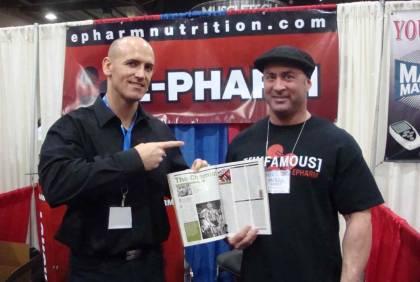The Chemist

Ursolic Acid
Q. Scott Welch posted that you’re launching a new ingredient called ursolic acid to the bodybuilding industry. Tell us about this stuff.
A. This ingredient really excites me—so much so that I spent money I didn’t have to be the first one to the market with a fully dosed product. The literature on this is impressive. By impressive, I mean the literature is published in fully accredited journals by authors with no conflict of interest. And the research is expansive, looking at mechanisms at the cellular and genetic level in depth. The first and foremost study regarding ursolic acid is one that has garnered a lot of press lately. It was published in the very prestigious journal Cellular Metabolism, and the research was performed by scientists from the University of Iowa. They used techniques to identify genes that were turned on and off by two muscle catabolic stressors—starvation and denervation (think of spinal cord injury). They then turned to a huge database of gene (mRNA, actually) expression signatures from 1,300 candidate chemicals, and after screening for which turned the right genes on (the anabolic ones) and which turned the right genes off (the catabolic ones), they came to one that stood out: ursolic acid. The researchers then gave ursolic acid to starved mice and to denervated mice, and they found that it did indeed powerfully act as an anti-catabolic. They lost much less muscle than control mice.
15% More Muscle
The cool part is they went on to see if it acted as an anabolic. That is, they wanted to see what it did to normal mice on a normal diet. They feed ursolic acid to a group of mice for five weeks and then found that their muscles grew around 15 percent bigger than a control group of mice over the same period. The muscle fibers themselves appear markedly bigger under the microscope, so this was hypertrophy going on.
Increased Strength
The muscle was fully functional as well, which was demonstrated by measuring grip strength. The ursolic mice had a significantly stronger grip (I guess they made the mice hang on a tiny chin-up bar till they dropped or something). Now, you probably think that since the mice grew bigger muscles, they probably weighed more than the control mice. Such was not the case. That is because there was almost a proportional decrease in fat mass with respect to the increase in muscle mass. Essentially, the body was using the fat to fuel the energy needed to burn the muscle! That is what’s known as a recomposition effect, and it’s seen with agents such as clenbuterol. It’s not really seen with anabolic steroids though, since although “roids” are great for building muscle, they don’t really affect fat mass in such an obvious and direct manner.
How Does It Work?
The researchers finally looked at how ursolic acid worked (I told you—this paper is extremely thorough and comprehensive). Examination of which genes got turned on and which got turned off (via examining mRNA expression signals) showed strong signals for 18 being turned on and 51 being turned off. Two of the most potent ones to be turned off were ones strongly associated with muscle atrophy: atrogin-1 and MuRF-1. The most potent one to be turned on was the one that encodes IGF-1 in muscle. The local production of IGF-1 is perhaps the single most instrumental process in the muscle hypertrophy response, as it initiates the key steps of satellite cell recruitment into new myonuclei and protein synthesis via the kinase Akt. So, that paper was great, and it’s what really convinced me that this stuff has huge potential to be the real deal (once we figure out how best to use it and what the best dose is. But other research on ursolic acid has been published showing some other really cool things. A 2008 study demonstrated that ursolic acid possesses good aromatase inhibitory activity in vitro, meaning that it can potentially help reduce estrogen production in the body and increase testosterone. It also has been shown to be anabolic on bone via stimulation of osteoblast formation. Of particular interest to me, a 2010 paper published in Bioorganic and Medicinal Chemistry showed that ursolic acid and some of its derivatives are potent and selective inhibitors of the tissue-specific cortisol-elevating enzyme 11b-HSD1.
Liver Protective
And finally, if you’re a drinker, you might be interested to know that a 2006 paper in Life Sciences showed that ursolic acid protects the liver from toxicity due to ethanol consumption. And then there are anti-cancer, antioxidant, antiviral uses ... the list really goes on and on. So, the bottom line is that I think this supplement is going to be big. I have a good track record of picking winning ingredients in the supplement industry, so you shouldn’t dismiss this one. In fact, I’ve used it for a few weeks, and what I have to report is an obvious and dramatic loss in body fat with a maintenance of muscle. I wasn’t even trying to diet, but I found that my appetite was curbed on the stuff. Maybe it’s because I didn’t need to eat, since it was making my body feed off my fat. I don’t know. Anyway, I hope to be the first to market with this stuff.

